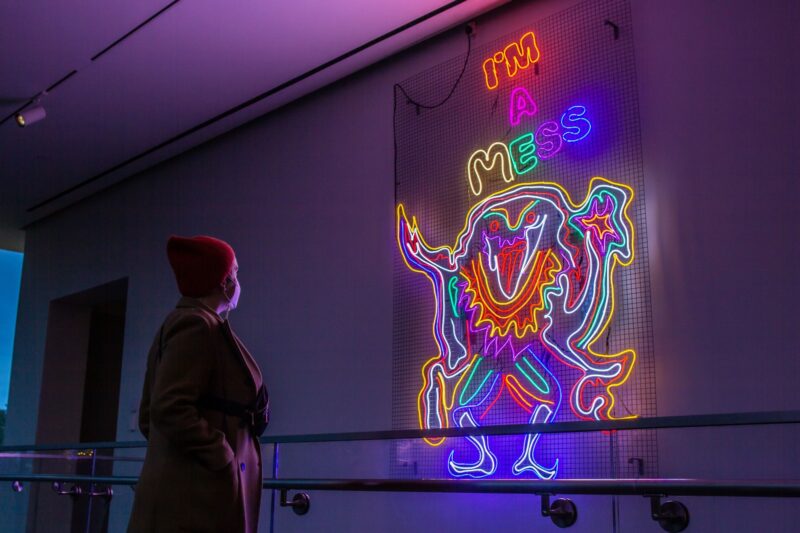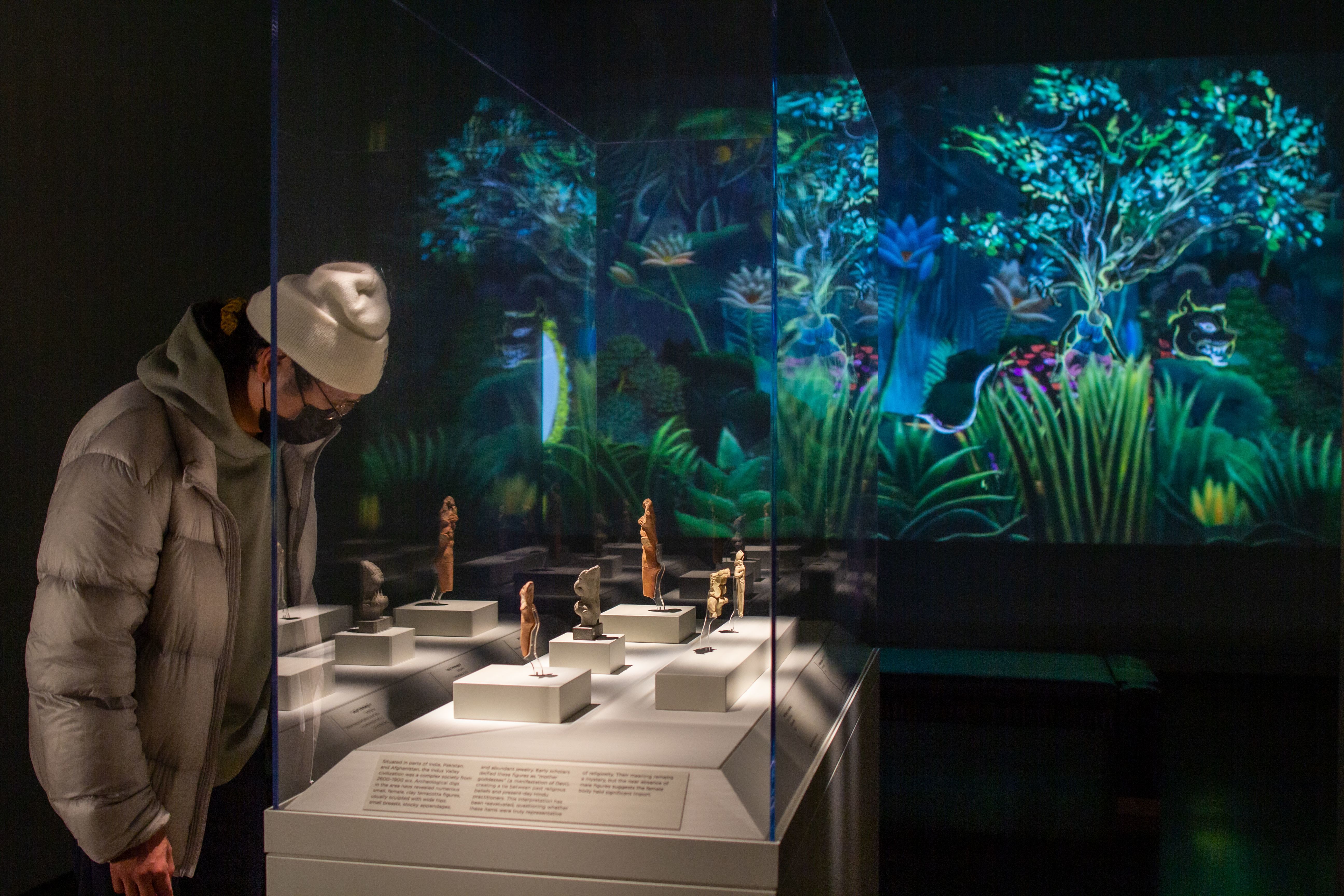Embodied Change Teaches Us About What We Inherit
Review of Embodied Change: South Asian Art Across Time presented by Seattle Asian Art Museum
Written by Teen Writer Aamina Mughal and edited by Teen Editor Esha Potharaju

When you walk to the back of Seattle Asian Art Museum, across from the floor-to-ceiling windows looking out over Volunteer Park, you experience a neon vision. The museum’s Embodied Change: South Asian Art Across Time starts here with Chila Kumari Singh Burman’s visual art piece Kali (I’m A Mess). With this commencing motif, Burman uses a historically revered Hindu goddess to reflect on societal concerns from the year of its conception, 2020. The words “I’m A Mess” glow above a technicolor image of Kali, eyebrows raised and tongue out. Although this is not a message commonly associated with the figure, Burman uses Kali as a symbol of rebellion and liberation to ask the question—“Can Kali drive time forward into a brave new world where we are no longer a mess?” In the 6th century, the Hindu philosophical text Devi Mahatmyam, or “Glory of the Goddess,” denoted when the worship of the female body became a part of Hindu tradition, which set the stage for works like Burman’s in the 21st century.
Burman’s work demonstrates how historical images, the ones deep rooted in cultural history, can be used to make implications about our modern world. This idea is echoed throughout this exhibit. Although South Asian Art cannot be defined as one thing, as South Asia and South Asian identities do not take a singular form; as she shared in an interview, it was a goal of the curator Natalia di Pietrantonio, “to show the expanse of the South Asian field by purposely including artists from across the diaspora.” This idea of dynamic identity and reclamation are echoed throughout Embodied Change and are told through the lens of the human body, specifically the female form. One thing that I believe unites these works is the burden of inheritance. There are certain things that we inherit through our heritage without us making the choice to do so. What we do choose, however, is how we carry this inheritance.
Identity is the intersection between how we perceive ourselves and how others view us, so to navigate identity is to find a balance between those two things in a way that is authentic to your experience. Embodied Change showcases this struggle. Francis Newton Souza’s 1987 self-portrait, for example, grapples with the search for a sense of belonging as a Goan-Catholic. Similarly, Brendan Fernandes’s locally-captured series of digital prints, As One IX, shows the human body in a range of iterations. His work resists one identity and “forges a bridge between the inanimate and animate”. Fernandes showcases the body in different permutations and employs masks from the Seattle Art Museum to contrast this movement and in doing so demonstrates the ever-moving nature of identity. A personal favorite of mine, Burman’s Punjabi Rockers corroborates these themes by using images of South Asian history and images from pop culture to subvert South Asian stereotypes and portray how dynamic South Asian identity is. This is such an important thing to showcase, but when di Pietrantonio says “I hope that audiences walk away with a greater understanding of activist artists who embody multiple identities,” I can’t help but mourn a version of this exhibit that more wholly fleshes out the intersectionality of South Asian identities. In other words, subverting stereotypes is the bare minimum and I do believe that this exhibit could have done more to move past that and towards the complexities of the intersectional South Asian identity.

One compelling part of the composition of this exhibit was the digital aspect. There were three rooms which showcased film in insightful and intentional ways. Chitra Ganesh’s 2022 “Before the War'' is the paramount of what it means to effectively use a medium. Ganesh uses figures from Hindu and Indian nationalist comics from her childhood and asks if there was a time before war. This installation is placed cleverly near votives, objects pertaining to religious worship, which portray goddesses from early Indus Valley civilizations. These votives are largely considered the first iterations of South Asian art so in this way, while the votives appear static, the images used in Ganesh’s video are constantly regenerating. This creates a sense of rebirth, where historic images are grown into larger stories; this is especially impactful considering the fact that the source material of Ganesh’s piece have very controversial connotations. In the same way, artist Pushpamala N. uses photography to criticize how spiritual images have been commercialized and degraded into mass-produced visual platitudes. Kali is the goddess of destruction and protection. I can’t help but feel as if this exhibit serves to tell the viewer that preservation is a product of destruction and reconstruction. Like Ganesh and Pushpamala N., we must not only reclaim images but also reconstruct them and reorient them to find power in them.
The issue of inheritance is not so simple as to pertain solely to what is passed down to us. To inherit aspects of your culture is to examine it in a way that is not always comfortable and decide which parts of that you carry with you. Furthermore, you need to evaluate not just what you carry but how you carry it. The student-teacher duo, Baua Devi and Jagdamba Devi, are practitioners of Madhubani art from the Mithila religion, a practice that is passed down from mother to daughter. Each daughter, in turn, uses this tradition differently. Ganesh, in the same way, inherited images which she chose to reconstruct. All of these artists inherited a history and we have had the honor to witness how they chose to carry it and present it.
Although I think that more could have been done in terms of the composition and flow of the exhibit, it would be hard to call Embodied Change anything but a success. I think that a chronological or more clearly thematic progression would have helped shape the viewer’s experience, especially considering the diverse range of stories told, more could have been done to create a cohesive narrative that still acknowledges that diversity. That being said, the exhibit mirrors its muses by resisting one interpretation. From identity, to reclamation, to inheritance, I believe that commendable work has been done here to show a three dimensional, compelling progression of South Asian Art.
Lead Photo: Photo by Natali Wiseman.
The TeenTix Newsroom is a group of teen writers led by the Teen Editorial Staff. For each review, Newsroom writers work individually with a teen editor to polish their writing for publication. The Teen Editorial Staff is made up of 6 teens who curate the review portion of the TeenTix blog. More information about the Teen Editorial Staff can be found HERE.
The TeenTix Press Corps promotes critical thinking, communication, and information literacy through criticism and journalism practice for teens. For more information about the Press Corps program see HERE.


